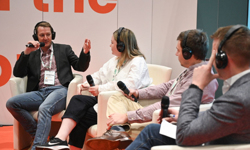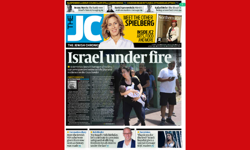Broadcaster Sue Nelson kicked off the AOP Autumn Conference by reminding delegates of the three key themes of the day: mobile first, the need for scale and the role of data. The day was an invigorating mix of keynotes, panel sessions and case studies with over fifty speakers taking part. These are some of the things I took away from the conference:
1. No rest - the pace of change is going to accelerate.
Google’s David McMurtrie had recently detected a “huge increase in the rate of change”. Everyone is connected and there is little downtime in the digital world. We live in the age of the always-on-consumer.
2. Programmatic is everywhere.
First used as a search term just last year, ‘programmatic’ is growing fast, but it is just the beginning. Programmatic embraces everything that is automated, and we should not fear it, says David: “The more automation, the better you’ll perform.” Obviously, it has a particular relevance in the area of digital ad sales, and Manning Gottlieb OMD’s Katie Eyton expects the bulk of “standard inventory to eventually be traded programmatically”.
3. Avoid commoditisation through differentiation.
The way to counter ever decreasing digital ad yields is three fold, says David: Firstly, “create unique inventory packages”; secondly, “sell your audience at scale”; thirdly, “leverage richer canvasses at scale”. Scale is clearly key, but it’s equally important for publishers to take ownership of their data and mark it up properly! Someone from one of the agencies complained that too much publisher inventory is poorly labelled; there’s not enough differentiation - “still too much run of network”. Another said: “I guarantee you’re sitting on a treasure trove of data – if we collaborate more, it will unlock opportunities. The publishing industry is very protective of its data, but it needs to open up!”
4. One size does not fit all; we live in a multi-screen world.
Publishers should not see things in black and white. It is not ‘desktop or mobile’, or ‘tablet or smartphone’. Consumers are now using multiple screens, often simultaneously. A search might begin on a mobile device, but conclude on a desktop. Publishers need to identify how people use different screens and deliver accordingly. David McMurtrie warned that “brand elasticity can only stretch so far; if you don’t optimise for different devices, it will snap.” As Hearst’s Rebecca Miskin said, “as consumers, we all know that non-optimised sites are incredibly irritating.” Ease of use is paramount, because, she said “users do not want to have to make any effort to consume any content on any device.” We really do need to give it to them on a plate.
5. And ... more screens are on their way.
We all know about Google Glass, and Samsung recently unveiled their smartwatch. David McMurtrie bets that “in three years’ time, there will be a new screen we’ve never even thought of.” Publishers cannot afford to wait – they must embrace the multi-screen culture right away.
6. Brand budgets represent the next big opportunity.
Traditionally, the big brand advertising budgets have been spent on TV. David McMurtrie is not advocating we all try to become TV channels, but video is the opportunity through which the digital world can capture a bigger slice of the big brand action. There are three things publishers need to focus on, he says: firstly, demonstrating precise targeting; secondly, devising incredible formats; thirdly, producing meaningful measurement.
7. Mobile: closing the revenue gap.
Clearly, mobile is where the action is. Incisive Media’s Tim Weller quoted a Google statistic that “65% of all interactions start with mobile”. AOP’s Tim Cain, unveiling the results of the latest AOP Census, highlighted the mismatch between mobile traffic and mobile revenue: “42% of publishers see 20% of their traffic coming from mobile and tablets, but only 3% of their revenue.” Making the mobile user experience as good as possible, and closing this revenue gap is a top priority for publishers.
8. Breaking down the silo culture is really hard.
As Future’s Jim Douglas said, there are two types of silo: subject and skill, and it’s “really hard to tackle it from an organisational point of view”. Future is trying to do it by encouraging and rewarding collaboration. In their project teams, they are getting as many people from different departments in the room as possible, so they can all see the wider picture. Rebecca Miskin found that locking away their virtual teams, out of the office, for a couple of days and relieving them of their day to day responsibilities also worked well.
9. Broadcasting is giving way to narrow-casting.
Underpinned by data, the one to many communication, implicit in the print model, but often deployed in the digital space too, is giving way to 1:1 communication, where messages are being tailored to the individual depending on what you know about the visitor. But, a word of warning: sometimes it’s not suitable to let on quite how much you know about the visitor, because it can be borderline creepy.
10. Look outside publishing for sources of inspiration.
Sue Nelson asked the panellists in the ‘Organisational Structures’ session, where they looked for their inspiration. Future’s Jim Douglas recommended the book ‘Innovate the Pixar Way’; Hearst’s Rebecca Miskin cited the example of the British Cycling team, which started with a blank canvass and created something formidable; Haymarket’s Patrick Fuller looked to other industries for his inspiration, finding useful parallels in Toyota’s approach to lean manufacturing!
The most popular session of the day (standing room only) was ‘What do agencies want from publishers’, which shows just how important the whole area of digital ad sales is becoming, and perhaps just how little publishers know about RTB et al.
And a final thought to leave you with, courtesy of Incisive Media Group Chief Executive Tim Weller: “Creativity is great, but plagiarism is faster.”












